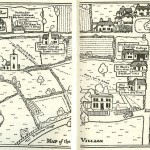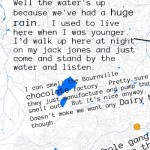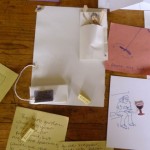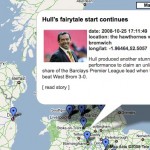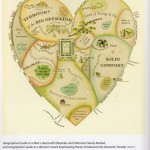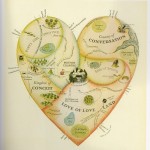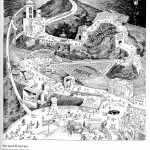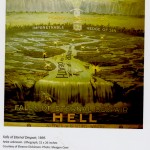STORIES, MAPS, MEDIA: DESIGNING WISCONSIN EXPERIENCES
Lecture T 1:20-2:10 & Studio R 1:20-2:10 in Microbial Sciences 1520, plus Workshop Sections W elsewhere
Prof. Jon McKenzie: Office hours W 1:00-3:00 DesignLab, PA Laini Kavaloski: TA Katie Schaag: Office hours TR 12:10-1:10 Microcosm Cafe, TA Brandee Easter: Office hours TR 12:10-1:10 Microcosm Cafe,
Description
This class explores the past, present, and future of Wisconsin through stories, maps, and media, teaching students digital communication skills in the areas of experience design, information design, and information architecture. Exploring their own stories and maps as well as public archives and databases, students learn analytic and synthetic methods for thinking and living in the 21st century while contributing to the future of the Wisconsin experience.
Students will learn three design frames: CAT (conceptual, aesthetic, technical), UX (user experience, information architecture, information design), and Design Thinking (desirability, feasibilty, viability), while also exploring the role of narrative, maps, and media to structure knowledge and experience in both physical and virtual space. The course consists of weekly lecture, discussion, and studio sessions. Collective and group training/demo studios will focus on software skills; research, design and technical resources; and issues such as copyright/fair use. Separate discussion sections will bridge lecture and training/demos, enabling students to integrate concepts and techniques through critical and creative practice, with students producing and evaluating websites, images, stories, and presentations.
In “Stories, Maps, Media,” students develop writing and design skills through three projects. In Project 1 (weeks 1-5), each student creates a WordPress “wide site” or creative sandbox mixing life, work, community and entertainment. Content will come from personal research and archives, with projects designed to provide students starter kits for future learning and living.
In Projects 2 and 3 (weeks 6-16), students role-play within groups as design consultants to research, re/design, and propose specific Wisconsin experiences, remediating archival stories, visuals, audio and other materials into graphic essays, documentary podcasts/radio, GPS-based games, and media performances. Topics and models include:
Earth Day • Mound Culture • Wisconsin Idea • Cold War University • Pail and Shovel • Wisconsin Comics • DOW DAY ARIS game • Lesy’s Wisconsin Death Trip
Design exercises and software training will support the main projects, and students will contribute to the evaluation of the conceptual, aesthetic, and technical dimensions of their work in emerging genres of scholarly communication. In addition to the projects and exercises, students will keep a design journal—a physical notebook (lined or unlined) or tablet device (e.g., iPad)—to capture good or bad design around you, using CAT and UX to note what makes them so and to generate good design of your own. Exercises and journals count as participation, as do attendance and discussion.
Course Grade: Project 1 – 20% Project 2 – 20% Project 3 – 40% Participation – 20%
Attendance: This is a demanding course which requires your regular attendance. More than three absences is grounds for a full letter grade reduction. It is expected that students provide adequate and reasonable advance notice to faculty/instructors in order that they can ensure that an accommodation is made.
Plagiarism: UW takes Academic Integrity very seriously. The internet has made plagiarism or the unattributed citation of other’s work very easy to do—but also easier to detect. It is always smart to properly credit others (it shows you’ve done your research) and yourself (it shows you’ve done your thinking and making).
Schedule
Part 1: Stories, Maps, |
Media |
|
TUES – LECTURE |
WED – WORKSHOP SECTIONS |
THUR – STUDIO |
9/2 Intro to course and Part 1 |
9/3 IntroductionsAssign Exercise 1: memory map
|
9/4 Bechdel, Fun Home – Chap 1-4 DesignLab info sheetVideosA Conversation with Alison BechelCreating “Fun Home: A Family Tragicomic”Fun Home: A Literary Autobiography |
9/9 Bechdel, Fun Home – Chap 5-7 |
9/10 Discuss Fun Home and crit Exercise 1 |
9/11 STS – WordPress |
9/16 Ulmer, Internet InventionChap 1 Chap 3+4Assign Project 1Ulmer sites and resourcesEmerAgencyBystoryTheory of the Manifesto – CATTt |
9/17 Discuss UlmerExercise 2: site map |
9/18 Mystory wide site workshop |
9/23 Turnbull, Maps are Territories website pdf Part 1 pdf Part 2Sample wide sitesFustercluckCosmogrammingJenny ZamzowThe Thinking MachineVision Problems |
9/24 Drafts due for preliminary crit |
9/25 No class: DesignLab appts |
9/30 Cosmogramming |
10/1 Proj 1 due |
10/2 Media ShowcaseStudent presenters and TA moderators |
Part 2: Designing |
Wisconsin |
Experiences |
10/7 Intro to Part 2 and WI TopicsAssign Project 2 and JanikSample sites a b c d |
10/8 Discuss role-playing Form groupsMound Culture Background: a b c Maps Images Drawings and photographsCold War University Background: a b cWisconsin Comics Background: a b cEarth Day Background: a b c ImagesPail and Shovel Background: a b |
10/9 Janik, A Short History of Wisconsin Visitor: Erika Janik |
10/14 Introduce Design ThinkingBrown |
10/15 Field trip to Wisc Hist’l Society |
10/16 Visitor: Aaron Bird Bear Group Workshop |
10/21 Archives RoundtableRosemary Bodolay, Michael Edmonds, Carrie Kruse, Jon Prown
|
10/22 Draft due |
10/23 Visitors:
|
10/28 Assign Project 3
|
10/29 Proj 2 Due: Firm site and preproposalSTS: iMovie/ARIS |
10/30 Showcase
|
11/4 Information Architecture Wurman, Applebaum, Bradford |
11/5 Workshop on project iA |
11/6 Read Wisconsin Death TripLesy skype-in |
11/11 Experience Design Duarte, ResonateSample proposals: a b c d |
11/12 Storyboards due
|
11/13 Workshop |
11/18 Information DesignEdward Tufte,“Escaping Flatland,”“The Cognitive Style of PowerPoint”Tufte websiteDavid McCandless, Visual Miscellaneum McCandless websiteA Periodic Table of Visualization Methods |
11/19 Draft proposals due |
11/20 Place-based learningVistors: Jim Matthews, Daniel Einstein |
11/25 Redesigning ExperiencesPine and Gilmore, The Experience EconomyFoucault, “How an ‘Experience-Book’ is Born”Ward, “Sustaining Strategic Transitions in Higher Education” |
11/26 Draft video/game due |
11/27 No class: Thanksgiving |
12/2 Transmedia StorytellingDesignLab, et al: “Wisconsin Idea and Transmedia Storytelling,” “Midwestern Voices, Midwestern Vision” Wisconsin Farms Oral History ProjectIowa Digital Engagement and Learning Initiative |
12/3 Draft of all deliverables due
|
12/4 Presentation workshop |
12/9 Showcase 1 |
12/10 Proj 3 due |
12/11 Showcase 2 Concluding discussion & feedback |
|
|
|
|
Materials (books with “*” are available in UW Bookstore; books with “•” will be assigned in Part 2)
Applebaum, Ralph. 1997. Untitled essay. In Information Architects. Ed. Richard Saul Wurman. New York: Graphis Inc. Pp. 150-161.
*Bechdel, Alison. 2007. Fun Home: A Family Tragicomic. Boston: Mariner Books.
•Buhle, Paul. 2009. Wisconsin in Comics Madison, WI: Borderland Books.
Bradford, Peter. 1997. Introduction. Information Architects. Ed. Richard Saul Wurman. New York: Graphis Inc.
•Brennan, Linda Crotta, 2013. When Rivers Burned: The Earth Day Story. Amherst, NH : Apprentice Shop Books.
Brown, Tim. 2009. Change by Design. New York: HarperCollins.
*Duarte, Nancy. 2010. Resonate: Present Visual Stories that Transform Audiences. Hoboken, N.J.: Wiley.
Foucault, Michel. 1991. “How an ‘Experience-Book’ is Born.” Remarks on Marx. New York: Semiotext(e).
IDEO. 2011. Human Centered Design Toolkit. <http://www.ideo.com/images/uploads/hcd_toolkit/IDEO_HCD_ToolKit.pdf>.
*Janik, Erika. 2010. A Short History of Wisconsin. Madison, WI: Wisconsin Historical Society Press. *Lesy, Michael. 2000. Wisconsin Death Trip. Albuquerque: University of New Mexico Press.
•Levin, Matthew. 2013. Cold War University: Madison and the New Left in the Sixties. Madison : The University of Wisconsin Press.
•Loew, Patty. 2013. Indian Nations of Wisconsin: Histories of Endurance and Renewal. Madison, WI: Wisconsin Historical Society Press.
*McCandless, David. 2009. The Visual Miscellaneum: A Colorful Guide to the World’s Most Consequential Trivia. New York: Harpers.
McKenzie, Jon. “Towards a Sociopoetics of Interface Design: etoy, eToys, and TOYWAR.” Strategies: A Journal of Theory, Culture and Politics 14.1 (2001): 121-38.
Pine, B. Joseph II, and James H. Gilmore. 1999. The Experience Economy: Work is Theatre and Every Business is a Stage. Boston: Harvard Business School Press.
Tufte, Edward. 1997. Visual Explanations: Images and Quantities, Evidence and Narrative. Cheshire, CT: Graphics Press.
Turnbull, David. 1994. Maps are Territories: Science is an Atlas. Chicago: Univ. of Chicago Press. <http://territories.indigenousknowledge.org/home/>.
Ulmer, Gregory L. 2003. Internet Invention: From Literacy to Electracy. New York: Longman.
Ward, David. “Sustaining Strategic Transitions in Higher Education.” Educause Review 48:4 (July/August 2013): 12-22.
Wurman, Richard Saul, ed. 1997. “Introduction.” In Information Architects. Ed. Richard Saul Wurman. New York: Graphis Inc.

